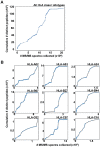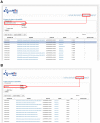The SysteMHC Atlas project
- PMID: 28985418
- PMCID: PMC5753376
- DOI: 10.1093/nar/gkx664
The SysteMHC Atlas project
Abstract
Mass spectrometry (MS)-based immunopeptidomics investigates the repertoire of peptides presented at the cell surface by major histocompatibility complex (MHC) molecules. The broad clinical relevance of MHC-associated peptides, e.g. in precision medicine, provides a strong rationale for the large-scale generation of immunopeptidomic datasets and recent developments in MS-based peptide analysis technologies now support the generation of the required data. Importantly, the availability of diverse immunopeptidomic datasets has resulted in an increasing need to standardize, store and exchange this type of data to enable better collaborations among researchers, to advance the field more efficiently and to establish quality measures required for the meaningful comparison of datasets. Here we present the SysteMHC Atlas (https://systemhcatlas.org), a public database that aims at collecting, organizing, sharing, visualizing and exploring immunopeptidomic data generated by MS. The Atlas includes raw mass spectrometer output files collected from several laboratories around the globe, a catalog of context-specific datasets of MHC class I and class II peptides, standardized MHC allele-specific peptide spectral libraries consisting of consensus spectra calculated from repeat measurements of the same peptide sequence, and links to other proteomics and immunology databases. The SysteMHC Atlas project was created and will be further expanded using a uniform and open computational pipeline that controls the quality of peptide identifications and peptide annotations. Thus, the SysteMHC Atlas disseminates quality controlled immunopeptidomic information to the public domain and serves as a community resource toward the generation of a high-quality comprehensive map of the human immunopeptidome and the support of consistent measurement of immunopeptidomic sample cohorts.
© The Author(s) 2017. Published by Oxford University Press on behalf of Nucleic Acids Research.
Figures





References
-
- Neefjes J., Jongsma M.L.M., Paul P., Bakke O.. Towards a systems understanding of MHC class I and MHC class II antigen presentation. Nat. Rev. Immunol. 2011; 11:823–836. - PubMed
Publication types
MeSH terms
Substances
Grants and funding
LinkOut - more resources
Full Text Sources
Other Literature Sources
Research Materials

